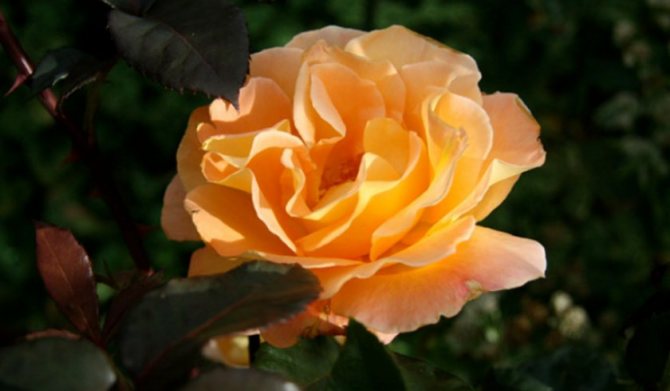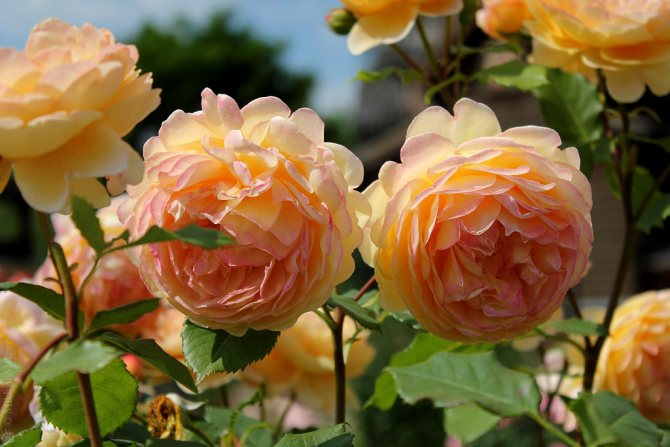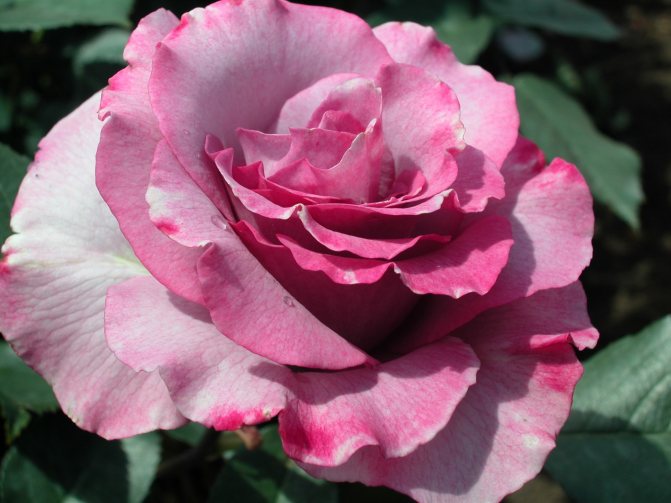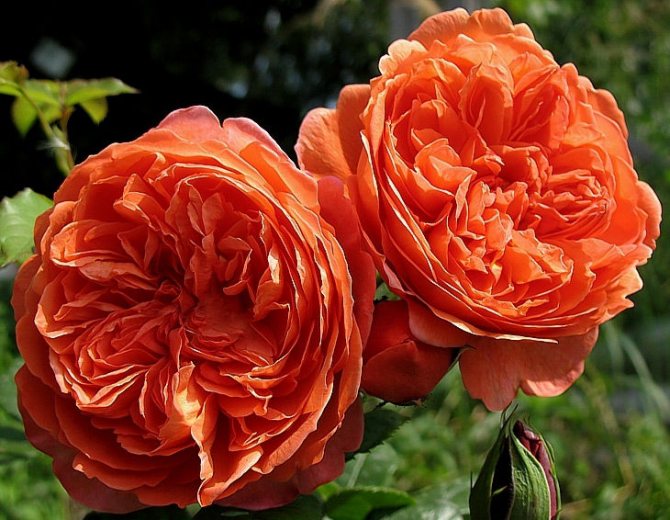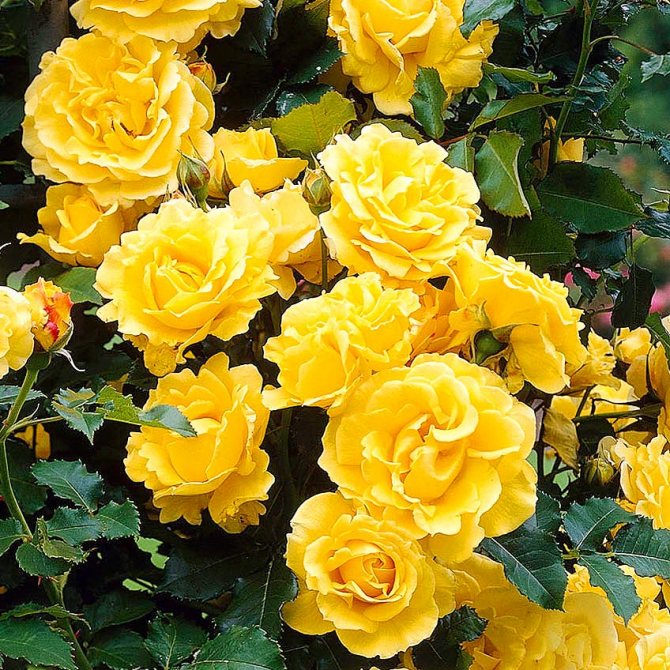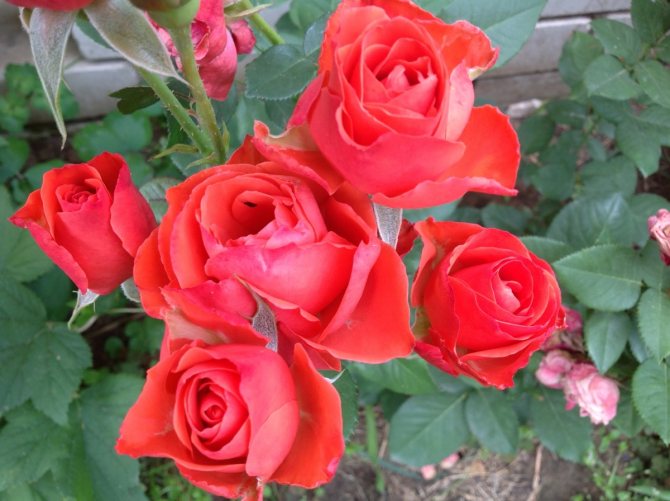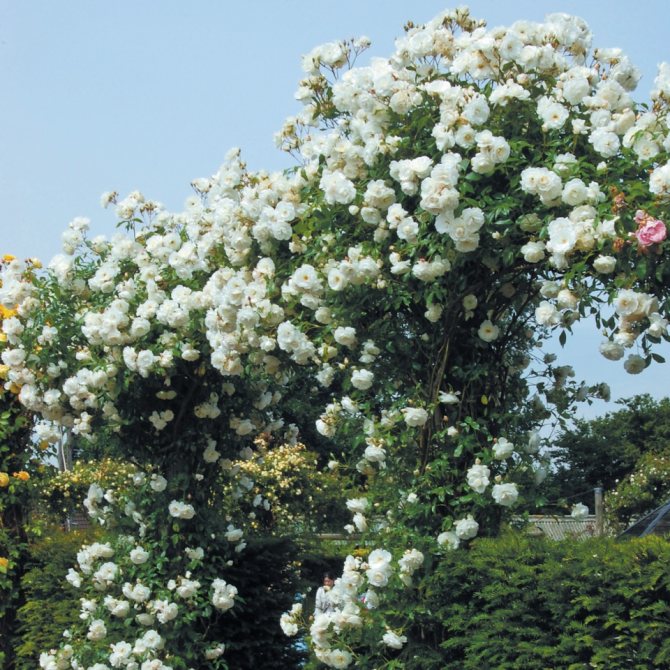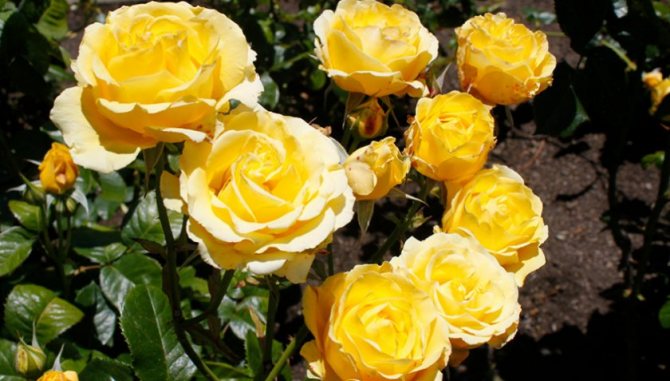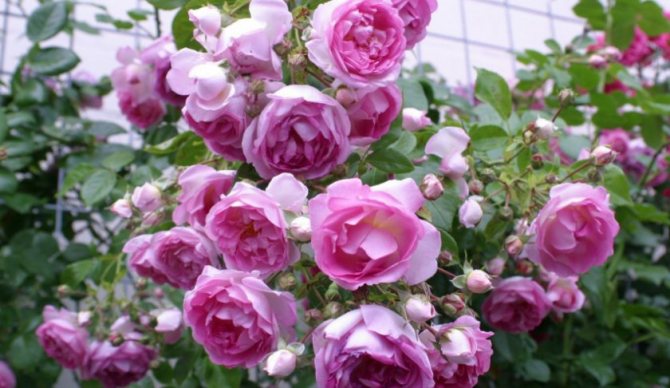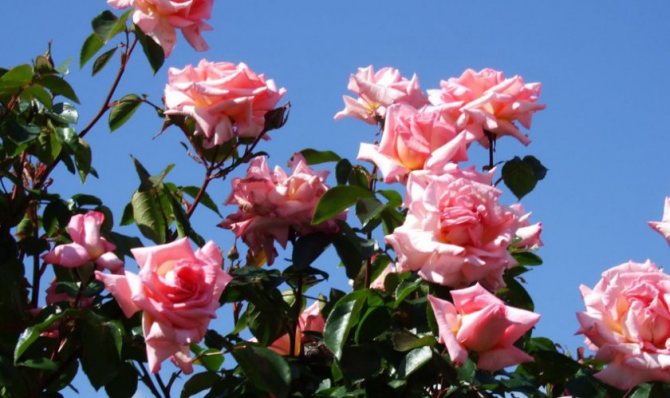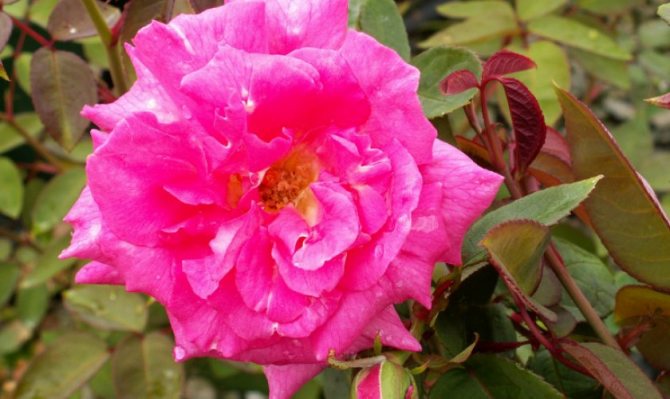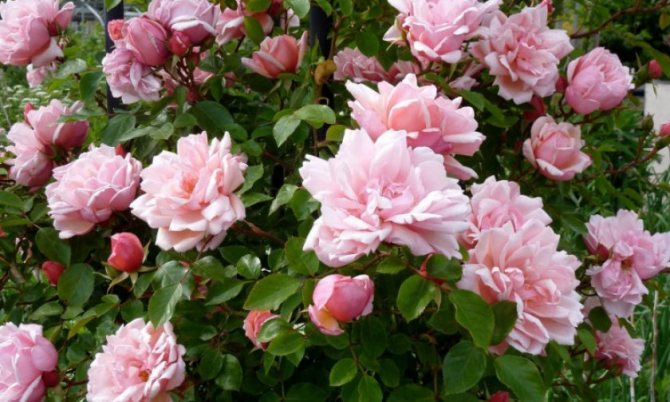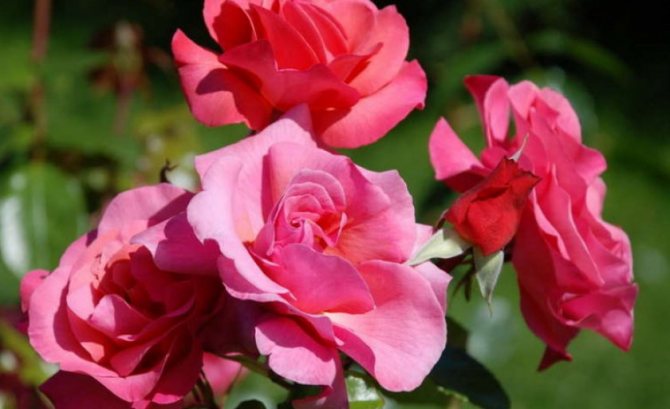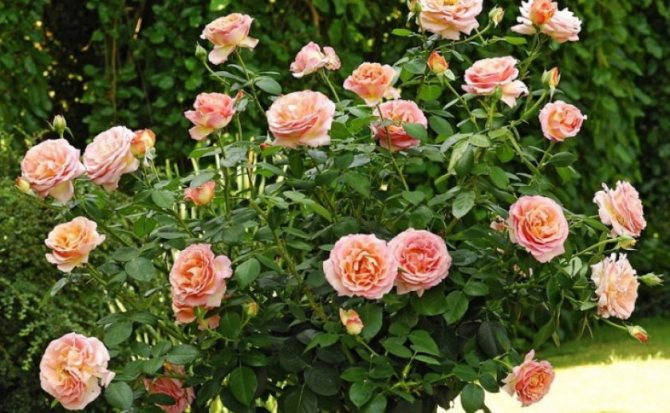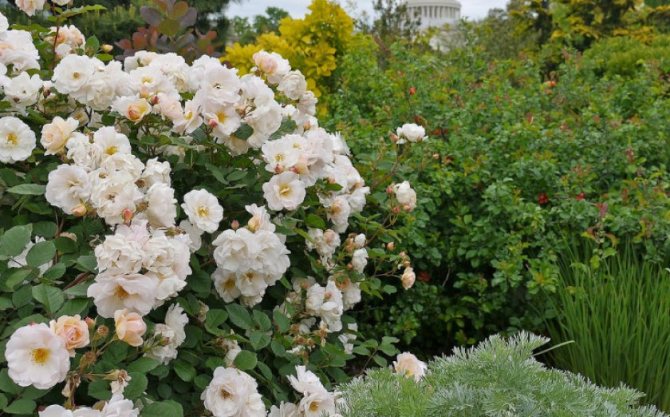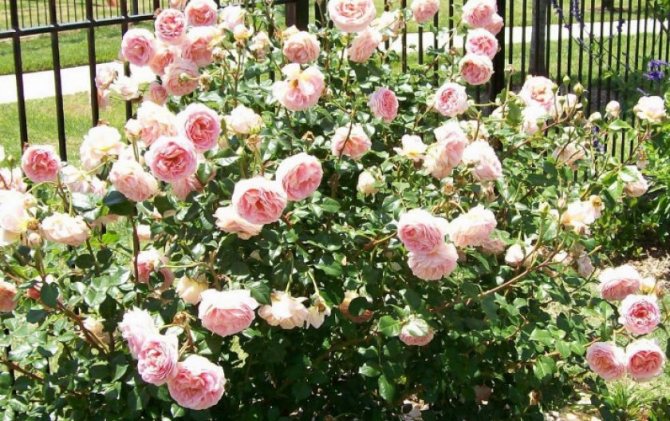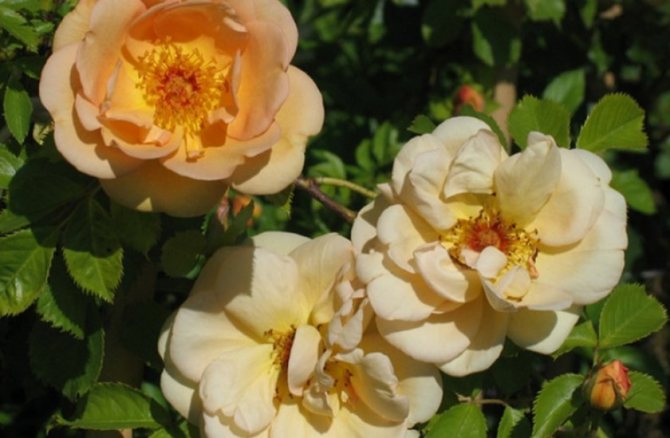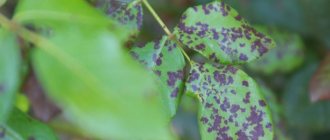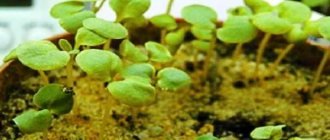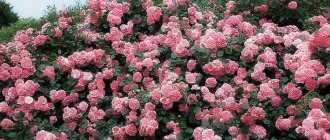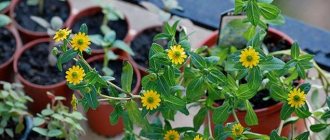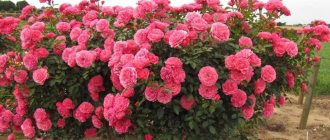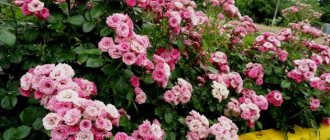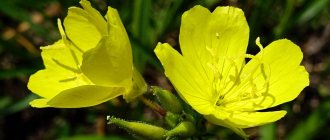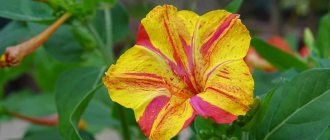Blue Girl
The buds have a silvery-lilac, lavender color, in partial shade it gives more pink tint. Diameter up to 12 centimeters. There are 20-40 petals in the bud. The blossoming flower has a light fruity aroma and continues to bloom until the very cold, therefore, it is considered one of the most frost-resistant. Resistant to disease. The bush grows up to 80 cm. The only unpleasant feature is that during a strong wind it breaks out fragments of branched stems, so it is worth tying the bush. A rose can be called a "hard worker", there are a lot of buds on one bush, over the summer it gives four waves of gorgeous flowers. Ideal for collectors, it will enrich any garden with its unique touch.
Planting and care advice
In the open-air soil, sprouts with a height of 10-12 cm can be planted, after the establishment of stable warm weather.
Table 2. Dates in which you can plant sprouts of roses "Garden aroma".
| Region | Term | Temperature |
| The middle band of the Russian Federation | 20.04 – 20.05 | + 10 ° C |
| South of RF | 20.03 – 20.05 |
20.08 – 20.09
In all cases, it is recommended to cover the seedlings at night for the first time.
How to prepare for planting:
- dig up the site;
- apply organic fertilizer - 1 kg per future bush;
- at a distance of 0.4-0.5 m, dig holes into which the roots "go away" entirely;
- add a tablespoon of the recommended mineral fertilizer to them;
- free the roots of the sprouts from the soil in which it was previously;
- if necessary, cut off all shoots and remove weak ones;
- Water and sprinkle the planted roses abundantly.
If after 2 weeks new shoots do not sprout, cover the soil with foliage or sawdust - it will become more moist.
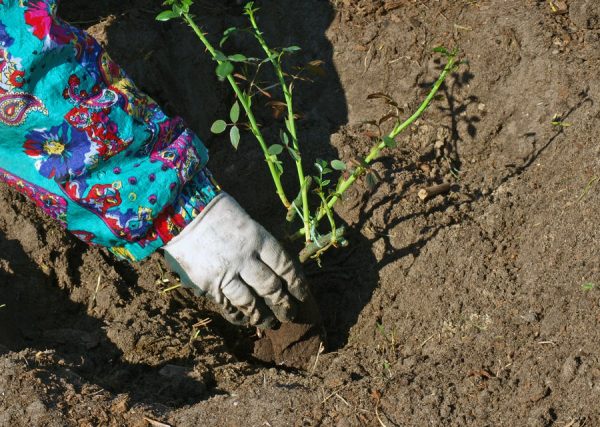
Throughout the summer period (or warm autumn - in the south), regularly feed the rose bushes with mineral fertilizers (at least 4 times over the entire period) and water moderately. Rose "Garden scent" loves dryness and heat, so it will rather suffer from flooding than from lack of moisture.
Important! The soil needs to be loosened so that the plants get enough oxygen and nutrients. Regular hilling will keep the rose bushes from losing moisture and drying out.
"Garden aroma" does not need frequent pruning, however, before wintering, it will not be superfluous to remove weak shoots that did not have time to woody, diseased or damaged by pests. For the winter, rose bushes need to be covered with spruce branches - if in your area the winters are cold and long. Young plants of the first year must be covered for the winter without fail. If the rose gets sick, treat it with fungicides - this is enough for recovery. You can read more about caring for a rose in autumn and preparing for winter in our article.


Fertilizers for roses
Long-term joy
The ever-flowering rose "Garden scent" is the place for a novice flower lover. She requires a minimum of attention to herself, and thanks for a simple care with the most delicate aroma and exquisite beauty.
This variety of roses only needs a lot of sun and warmth, minimal watering and feeding. Bushes of multi-flowered roses always look elegant and fresh, keep their compact size and do not give abundant growth. They are resistant to frost and disease, do not require complex treatment, in the southern regions they can not even be sheltered for the winter if the weather is relatively warm.
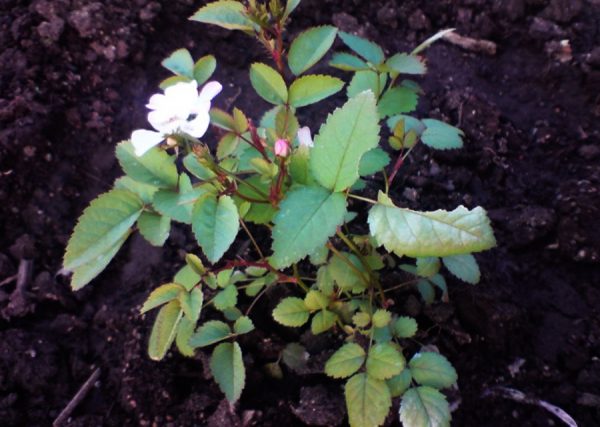

It is best to grow "Garden Scent" from seeds - roses are bright, beautiful and persistent, with rich flowering.Following simple recommendations, you can easily cope with the planting and reproduction of polyanthus varieties of roses.
Video - Growing a rose from seeds
81
O Sole Mio
A variety of hybrid tea roses. The flowers are golden yellow in color, bordered with a pinkish tint at the edges, the border disappears when the flowers begin to bloom. The diameter of the double bud is up to 11 centimeters. The aroma, at first, with hints of citrus, later the aroma of moss, pineapple, spices appears... The bush grows up to 120 cm high and up to 60 cm wide. The variety is endowed with excellent characteristics - it allows you to grow flowers in any climatic conditions. They are not afraid of rain and sun, they tolerate frost well.
Agrotechnics
All roses are warm and light-loving plants, therefore it is recommended to grow them in a sunny area or in partial shade conditions. The place of growth should be well ventilated, but there should be no gusts of wind and drafts.
Landing is done on a hill. If you neglect this rule, excess moisture will accumulate at the roots of the bushes, provoking the development of fungal diseases and root decay.
For your information! Care rarely includes specific requirements, as a rule, it is limited to watering, fertilizing, loosening and removing weeds, pruning and shelter for the winter.
Read also: How to properly clean a pomelo video
Today there are innumerable varieties of rose varieties. It is very difficult to choose the only one, but that does not mean that it is impossible. Every florist will definitely choose what he wants, be it a rose with a pronounced aroma or no scent at all.
Adding an article to a new collection
Fragrant roses are always highly valued, because they not only decorate the flower garden, but also fill it with a bright aroma. In this article, we will tell you which varieties of roses are worth paying attention to for those who wish to enjoy the heady scent of flowers.
Of course, it is difficult to reliably describe smells: everyone perceives them in their own way. In addition, the aroma of flowers depends on the weather, time of day and the phase of bud opening. Half-open roses have the brightest smell in the first half of the day, in sunny (but not hot) and calm weather.
The spectrum of rose aromas is striking in its variety. We never cease to admire some smells (the buds can exude aromas of lemon, vanilla, banana, cinnamon, melon, etc.), while from others we turn up our nose all the time (a very pungent smell, similar to turpentine, exudes a rose of thetis).
Still, most roses have a pleasant scent. Let's take a closer look at the best ones.
Types of fragrant roses
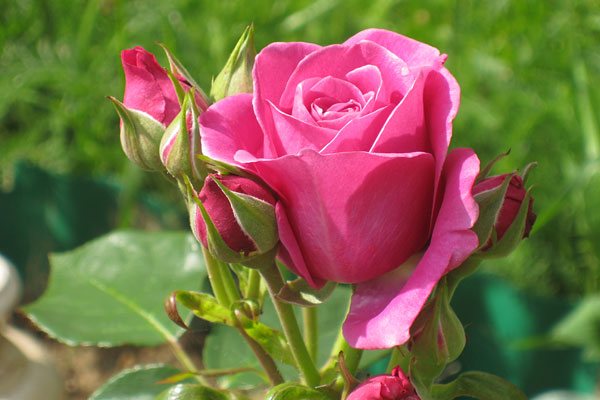

Roses are like perfume - it is impossible to immediately understand their scent. The first breath - subtle, easily evaporating notes, this is the mind of the rose. Take a second breath - and the heart of the flower will open to you, deeper shades are less volatile, the queen of flowers does not open her heart to everyone who passes by in passing. Bend over, trust, and she will reveal to you the most intimate. And then he will accompany you, presenting you with a gentle trail goodbye. Each rose has its own scent - there are those that emit the subtlest, barely perceptible aroma, others have a rich one. It is easy to recognize the scent of roses, to define the concept of the scent of a rose is not. Each variety expresses its own shades of aroma, varying degrees of intensity, saturation, its own nuances. Researchers say that of all varieties of roses, only 20% have very fragrant macaws.omat, and 25% do not have it at all, or it is very weak. The rest are somewhere in between.
In the morning, roses smell stronger, as if all the smell accumulated during the night is suddenly thrown into the surrounding air: "I woke up!" The fragrance also differs as the buds open: during blooming, their smell is stronger - after all, its purpose is to attract pollinating insects to itself. So that people admire the rose, its fragrance, the queen of flowers does not even suspect.
Scented roses are divided into types:
- shrub;
- flower beds;
- climbing.
Shrubs - up to 1 meter tall, often found in flower beds in gardens and parks, everyone can feel their aroma, bourbon and remontant roses are considered the most fragrant, their fragrance is called "pure".
Climbing - those that wind around the supports are distinguished by a long fragrant train not only in the immediate vicinity, but also in the distance.
Flower beds - have a less perceptible aroma, it can mix in the air with the smells of other flowers. Polyanthus and Floribunda varieties will allow you to enjoy the delicate fragrant cloud of a flower garden in your garden.
The best fragrant flower beds
They are often chosen for planting in rose gardens, in classic flower beds. Flowerbed roses include hybrid tea varieties, Floribunda and others.
Flowerbed varieties of roses, so beloved by flower growers, are distinguished not only by a delicate aroma, but also by a wide variety of colors. The bushes take up very little space in the garden, in the country, they grow from half a meter to a meter, which allows you to enjoy their aroma, but their most important advantage is their large flowers.
Among the most famous varieties of flowerbed roses:
- pink - Piroshka;
- pale pink - Myriam, Frederic Mistral;
- bright, deeply saturated - Auguste Renoir, Blue River;
- yellow, orange of all sorts of shades - Duftgold, Whiskey, Berolina, compact, Lolita, melon shade Paul Ricard, gentle pastel color Sebastian Kneipp.
- white - Evening Star, Margaret Merril.
Among the variety of flowers and aromas, other aromatic varieties should be distinguished.
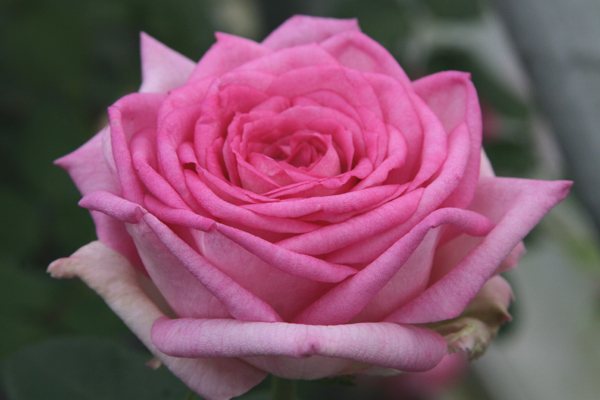

- Beverly is a cold pink hybrid tea with a strong, pleasant aroma. The height of the bush is up to 80 cm, it is very resistant to bad weather, it is able to bloom until October. Ideal for cutting, bouquets.
- Blue for Yue is a floribunda variety of unusual lilac-purple, sometimes blue color with a strong aroma. Unpretentious to care for, loves the heat, flowers stay on the bush for up to a week.
- Edit Piaf is a rose bush with red, dark red velvety flowers that blooms profusely and pleases with a strong pleasant aroma.
- Hybrid tea varieties have a strong aroma - a dark pink Parole rose with a flower diameter of up to 20 cm, a golden-pink Peace with a delicate but delightful scent, Princess Alexandra of Kent - its warm pink shade of flowers, as they fade, change their shade to cold ...
Scented shrub rose varieties
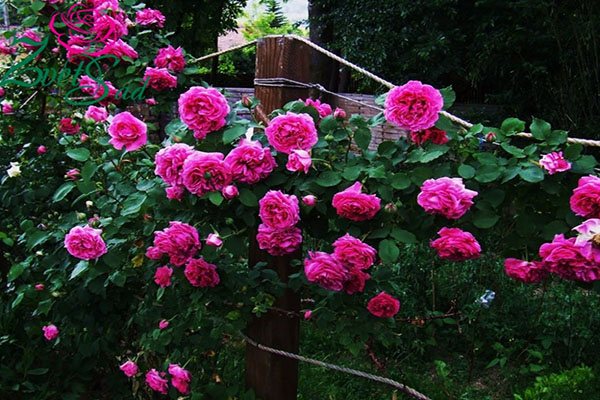

Shrub roses, often planted in parks and gardens, can reach a height of up to 2 meters. Among them there are more fragrant varieties, passing by a profusely flowering bush, you can enjoy the fragrance of the best "odorous" representatives of shrubs:
- Abraham Derby - apricot;
- Maygold is a tall bush with bright yellow flowers;
- Penelope - an unusual pearlescent shade;
- Colette is a two-meter shrub with delicately salmon fragrant flowers;
- Fantin Latour - a variety of a rose of a pale pink color, Ulrich Brunner Fils - a dense cherry-colored "odorous" meter-long shrub;
- Belle Story, Muscosa - intense pink shade;
- Rose de Resht is the crimson “queen of the garden”.
- A delightful hybrid species of musk rose - Felicia - not only surprises with its powerful, lush bushes, strewn with flowers of a pale pink color, but also with a bright, amazing aroma that envelops you, like a weightless blanket, from head to toe.
- A luxurious fragrant background is provided by a low, up to half a meter of pale yellow, sunny hue rose of the Charles Austin variety, pink with a mother-of-pearl shimmer Heritage and Souvenir de la Malmaison, the purple beauty Mme Isaac Pereire, which, according to flower growers, deserves the title of the most fragrant rose.
It is impossible to list all the varieties that surprise with their aroma - shrub roses are the most numerous and most "fragrant" type of roses, each variety has a special shade, a hint that makes it unique.
The enchanting scent of climbing roses
Climbing roses are a type of garden roses, they are vines up to 5 meters long. They are often used in landscape design, decorating park, garden gazebos, columns, arches, hedges. Special supports and gratings are created for them. Decorative vines bloom profusely, decorating parks, gardens, suburban areas not only with bright flowers, but also with a unique aroma. The only drawback when growing them in the middle lane, northern latitudes is the need to cover for the winter, saving from frost and cold weather, but in the south they bloom almost all year round... Despite this, landscape designers and florists grow them all over the place.
The most fragrant among climbing roses are the following varieties:
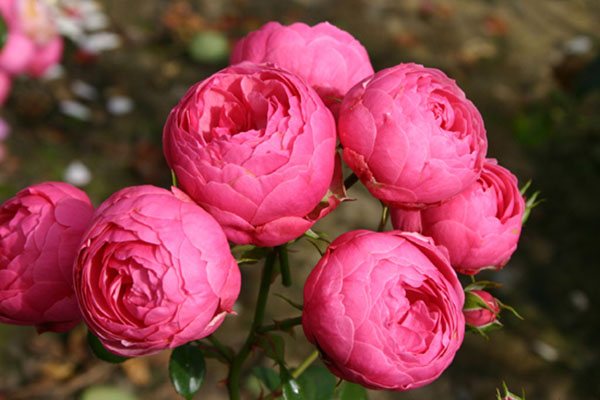

- Rosenresley - with dark pink flowers.
- Albertine is a 4-meter climbing beauty with a delicate apricot shade of flowers and a delightful, indescribable aroma.
- Compassion is a large-flowered, salmon-colored variety.
- Zepherin Drouin is a large-flowered Bourbon queen, devoid of thorns, with an unusual color - pink-red buds with white spots, bifurcations.
- Constance Spry - climbing branches of pink-red roses are suitable for decorating the walls of a house, a summer residence, a gazebo in the garden.
- Lagoon - has bright pink densely double large flowers, growers like it for its resistance to diseases, a strong, even heady aroma.
- Golden Gate - semi-double bright yellow flowers have a pronounced fruity aroma. In care, the rose is unpretentious, for which flower growers love it.
- Pomponella - Her unusual, pompom-like flowers have a deep pink color. Not demanding to care, not capricious, practically does not get sick, and the aroma spreads a delicate, delicious, incomparable.
- Jasmine is a vine variety with a delicate apple aroma. It will decorate any area - flexible three-meter lashes will wrap around the gazebo, arch, filling the air with a delicate scent, decorating the landscape with soft pink double flowers.
How to care?
Caring for small varieties of roses at home is simple, but each variety has its own characteristics. General rules boil down to the fact that it is necessary to give moisture to the flower, provide the soil with all the necessary nutrients and prune at the right time. A good place for planting bushes, compliance with all care measures will result in a magnificently blooming rose garden. In case of any problems with growth or flowering, you must immediately deal with the reason so as not to lose the entire flower garden.
For good growth and development of the bushes, protection from pests is needed, so do not forget about the spraying procedure. Preparation for wintering is also an integral part of caring for bushes, it can have several options. For cold climates, it is necessary to transplant small-flowered plants into a pot and put them indoors or cover them very well.
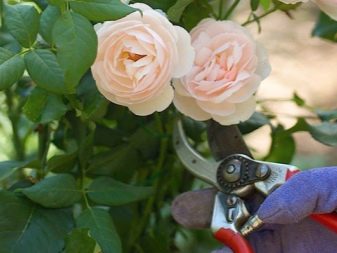

For the middle lane, it will be enough to carry out measures to protect the rose garden, which boil down to:
- breaking off flowers and peduncles;
- covering bushes with spruce branches;
- the construction of a wire frame, which will exceed the size of the bush by 10-20 centimeters;
- put this frame over the rose;
- cover the plant with insulation and a layer of film.
In addition, there are other equally important procedures such as pruning, feeding and pest control.
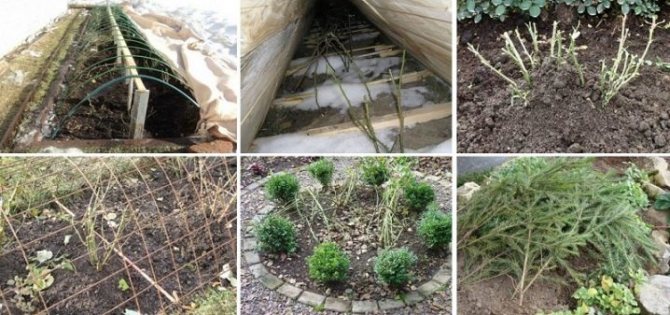

Top dressing
The fertilization procedure is important for creating a beautiful and lush rose garden, especially in the case of poor soil with a minimum composition of nutrients. It is important to carry out the feeding process according to the scheme:
- the first fertilizer is applied in the spring, after the shelter has been removed, it will be optimal to apply ammonium nitrate or urea;
- a month later, you must repeat the same course;
- as soon as the buds appear, it is necessary to apply complex fertilizers;
- at the end of summer, potassium nitrate or superphosphate is added to the soil.
Varietal varieties are often demanding on the soil, which means that you have to tinker with them, but the result will be worth the effort and time spent.
Watering
It is advisable to bring water under the bushes twice a day, before and after the active sun, but only in sunny and dry weather. If it is cloudy and not hot outside, one watering will be enough. In case of rain, there is no need to additionally moisten the ground, as this will lead to rotting of the plant roots. After each watering, it is necessary to loosen the soil and weed the weeds. Such abundant watering involves the introduction of a small amount of water. If it is not possible to spend so much time in the garden, you can water the roses once every few days, filling the soil well. In order to choose the right day for the procedure, you just need to assess the condition of the soil, if it is still wet, then it is worthwhile to wait and wait at least one more day. Young bushes consume more water than mature ones, as they need more strength and energy for the process of rooting and active growth.
The frequency and amount of watering will also vary depending on the flowering: when the buds appear, it is worth increasing the watering, during the blooming of the buds, moisture should be supplied in moderation. It is best to use settled water, which should be at room temperature, as cold plants can get sick. Watering is best done with a watering can rather than a hose.


Disease and pest control
The varietal variety of roses is huge, and they differ not only in external signs, but also in the degree of resistance to certain diseases. If you buy flowers from the market, there is a chance to learn about what the seedling can get sick, and how to treat it. In case of obtaining a rose of unknown origin, it will be more difficult to help her. To minimize the chances of being damaged by diseases and pests, you need to choose the right place for the bush and treat it with preventive solutions in a timely manner. Most often, roses are harmed:
- pink aphids;
- rose leafhoppers;
- spider mite;
- rose leaf rollers;
- rosy rotters.
Features of planting fragrant roses
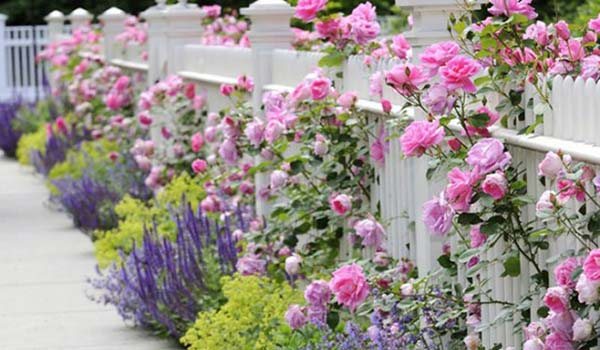

Choosing the varieties and the place where you will plant the "odorous" beauties, stop at the varieties that you like especially - in color, aroma. You should not choose the most fragrant if you are annoyed by strong odors, if you prefer subtle notes in the perfume. If you can change the perfume, then you will be sorry to throw out the rose bush.
Plant fragrant roses along paths, next to resting places, by gazebos, by the terrace - where you can enjoy the scent of rose bushes.
To enhance the aroma of the "queen" cloves and foxgloves are planted nearby. Lavender is considered the ideal partner for a rose. In such a neighborhood, the rose most reveals its aroma.
The Queen of Flowers justifies its name, for many centuries people have admired her bewitching beauty, extraordinary aroma, chanted, imprisoned in crystal bottles, but only in nature - in a park, garden - she will reveal to you the secret of a fragrant heart.
Testimonials
This year I had a plan to remember my garden with perennials. I needed one large flower bed, a rose garden, which I already wrote about, an alpine slide and a few more local plantings. To save money, and - what a sin to be honest - to experiment, I decided to grow some of the required plants myself from seeds. I'll tell you what I did and what didn't.
Lavender Invaluable help in growing lavender was provided to me by Catherine's article “Planting lavender in the hot earth. We look at the results. " In fact, it describes two methods of planting lavender: hot and cold. I just had two packets of seeds, so I tried both of them. Both worked, but I liked the cold one more. The packages of seeds were opened in one day: one batch went into the refrigerator for a month, the second - to germinate under the film. So the mass shoots were almost simultaneous, when the first batch had already left the refrigerator. It seemed to me that the lavender after stratification was stronger.But in the end, I selected 12 pieces from each crop - and I grew them. If I needed more, it would have been possible to save a few more plants, but this was a lot for me.
Lavender after a dive
In fact, it turned out to be easy to grow it. Water and water yourself. Still need to pinch. I missed this moment, she stretched out. But after pinching it began to fluff well. I planted it in the ground at the end of June (it could have been earlier, but there was not enough time).
The main planting site for lavender and fescue (we will talk about it later) immediately after planting
12 pieces - that is, one variety - I planted along the entrance path with a pair of fescue, the other variety I scattered around the garden in groups. Lavender grown from seeds should not bloom in the first year. But mine, apparently, did not know about it. When disembarking, one bush bloomed timidly.
Delicate lavender
I planted everything right under the July rainy season, so I did not water it. I didn't feed. Only loosened a couple of times along with weeding. One bush began to dry up. After a vacation in September, I discovered that he had changed his mind and overgrown with new leaves, but the other two began to shuffle. True, a mole walked under them, maybe caught the roots. But most of all I was surprised by the large number of peduncles! Of course, they will not have time to dissolve, but I see this as a good sign. Hope my lavender winters well. I'm going to cover it with spruce branches and covering material on top.
Lavender (right) in September
Gray fescue Along the front door, along with the lavender, I was supposed to grow fescue. I planted 4 packages (Aelita Lazurite), 5 seeds each. I planted separate pots with 2 seeds each. Only one thing did not come up.
The fescue has risen To be honest, I was going to separate the plants later, but I overexposed them and it was no longer possible to tear them apart. Sowed at the beginning of February, and they got into the ground together with lavender at the end of June. The photo after disembarkation can be viewed above in the description of lavender. The culture turned out to be completely problem-free in germination, cultivation, rearing and planting. This is how the mounds of fescue became at the end of September.
The most fragrant varieties of roses
Petals on the bed, essential oil in your favorite perfume, rejuvenating extract in a wonderful cream - the queen of the garden is beyond competition here! Its honey smell has always been associated with luxury. But are all their majesties so generous?
Burgundy rose 'Adam Messerich' known to gardeners since 1920. This picturesque bush up to 1.8 m in height blooms almost all summer.
At the sight of a lush pink bouquet, an involuntary desire to smell it arises, because a rose is associated primarily with an intoxicating aroma. Alas, sometimes this capricious princess leaves us literally with a nose - it turns out that she is completely deprived of her main dignity. But this is not a reason to be disappointed in the royal family! To experience the desired sensations, it is enough to come to the rose garden, inhabited by selected fragrant plants. Just imagine: fruity, tart, musky, spicy aroma ... Know breathe and enjoy! Moreover, some "thoroughbred" beauties can boast of a set of different scents in one "bottle".
The Poet's Wife '- english rose. Barely blooming flowers have a lemon scent that later becomes sweet.
The aroma session is not only pleasant in itself, but also good for health: after the "royal reception" you will feel peace and a burst of energy. And this scent is also a powerful aphrodisiac. It is not for nothing that there is no better sign of love than a pink bouquet: the giver can reasonably count on reciprocity!
'Blue Girl' hybrid tea rose differs in fragrant flowers of a light lavender shade.
What is the secret of the hypnotic effects of fragrant flowers? The fact is that our sense of smell is directly related to the pleasure center in the brain. At the same time, the smell itself has a purely chemical nature: we inhale tiny molecules of essential oils that form in thin glands on the surface of the petals and float in the air, especially on warm days in the morning. The most fragrant are just blossoming roses. Over time, the smell weakens, because the main goal - to attract pollinating insects - has been achieved.
Delicate scent 'Ghislaine de Feligonde' barely perceptible, but this is more than offset by the abundance of flowers.
Unfortunately, the payment for an exquisite gift from luxurious flowers is high: unlike their stingy sisters, fragrant roses fade quickly, and they do not last long in the cut. But true connoisseurs, confident that the smell is the very soul of the rose, value the elusive beauty even more.
Rose therapy
It is believed that the rose is the first flower from which the essential oil was extracted. It happened in Persia in the 10th century. Received rose oil, and, according to some information, quite by accident, the great Arab physician Avicenna. And since then, this oil, which is an aphrodisiac and possesses antibacterial and soothing properties, has been conducting its triumphant aroma all over the world.
Rose is not in vain recognized as the queen of flowers. She is not just extraordinarily beautiful, she smells, as one poet put it, "professional" - in other words, magnificent.
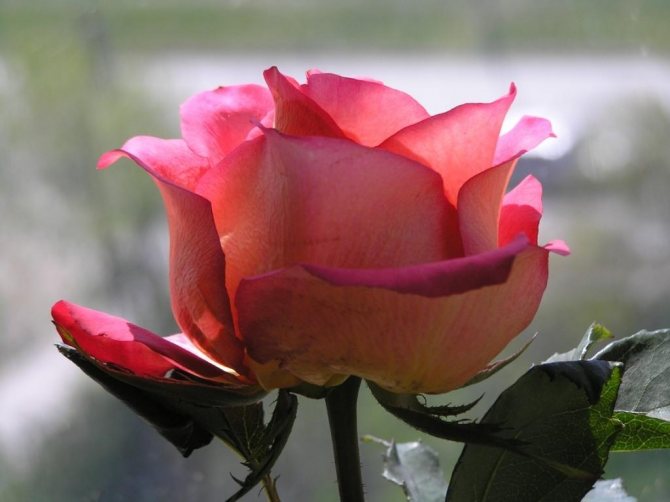

The scent of a rose calms the mind, calms the nervous system, relieves fatigue and headaches, increases vitality and resistance to various diseases, normalizes the pulse and helps in the treatment of tuberculosis. Used internally, rose oil acts as an anti-inflammatory and wound healing agent. At the level of psychological suggestion, the rose transforms a sad mood into a desire for self-improvement, helps to soberly assess the situation, find the roots of problems and solve them. Experienced interior designers know that a bouquet of roses placed in the bedroom promotes relaxation and helps to tune in to a good sleep.
The most fragrant of the fragrant
1. Have ‘Charles Darwin’ reddish buds, opening, turn into densely double bright yellow flowers. The height of this English rose is 1.2 m.
2. 'Kolner Flora' looks incredibly picturesque when drooping stems are decorated with double flowers. The rose grows up to 1.2 m and is famous for its excellent health.
3. 'Scented Whisper' - ground cover beauty up to 80 cm high with loose double flowers.
4. ‘Soul’ incredibly fragrant, such a bush up to 1.3 m high is distinguished by strong immunity and endurance.
5. Aroma ‘Herzogin Christiana’ very special, intensifies in the afternoon and evening. The growth of the rose is about 1.2 m.
6. ‘Ambassador 2014’ - tea-hybrid hardy beauty up to 80 cm high. Its exquisite flowers, light outside and orange inside, exude a fruity aroma.
What's in my smell to you?
- How does the place of growth affect the intensity of the aroma?
The intensity of the smell is most influenced by the heat and humidity of the air - the higher they are, the stronger the fragrance. Gardeners also noted that the flowers of a plant of the same variety smell stronger on clay soil than on sandy soil. Roses love the sun, but in a too hot place, the smell "burns out", especially in plants with dark flowers.
- Is it possible to determine the potential for aroma by the color of the flowers or the belonging of a rose to a particular group?
The color of the rose does not affect the scent in any way. Flowers of one shade or another can be very fragrant or odorless. But among the groups of roses there are differences: as a rule, shrubby and climbing roses smell most intensely, and among ground cover ones, on the contrary, there are many varieties that do not have a scent gene at all.
Soil preparation
A loamy soil rich in nutritious humus is suitable for the polyanthus Garden Aroma. Therefore, before planting in open ground, it is necessary to properly prepare this ground.
To do this, you need to shift in a 2-2-1 ratio:
You will have a crumbly nutritional formula perfect for this strain. The instructions attached to the seeds also indicate which mineral fertilizer additionally needs to be applied to the soil. If you are planting seeds not purchased from a store or obtained by yourself, and you do not have instructions from the manufacturer, add 2 handfuls of superphosphate to the mixture.Planning to grow potted flowers? Add perlite to the soil for drainage, moisture and successful germination.
Wood ash prices
Seed propagation
Rose seeds should be chosen as fresh as possible (if you buy them from the store, pay attention to the date of packaging). The fresher the planting material, the faster the germination and the more abundant the flowering.
Important! If you collect the seeds yourself, wait until the fruits turn red, cut them off. Peel the pulp, cover with sand in a glass jar and store (stratify) for 4 months at a temperature of +2 to + 5 ° C.
In early February, start preparing the seeds for planting. Why exactly on this date? There are 2 reasons for this:
- The bushes should get stronger for the coming winter. To do this, they must be planted in open ground in March-May.
- Seeds of polyanthus roses are tough-like. Therefore, they need to be cooked in winter so that they are ripe enough by the time they are planted in the ground.
Step-by-step instructions for growing a rose from seed
Table 1. Step-by-step instructions for growing a rose from seed.
| Act | Description |
| Treat with hydrogen peroxide or growth stimulants; | |
| Store for 10-14 days in a glass jar with sand or between cotton pads soaked in water, checking for mold; | |
| Soak in warm water for 2-3 hours before disembarking; | |
| Fill a shallow spacious container with prepared soil; | |
| Make a 1 cm depression in the soil; | |
| Place seeds (2 to 5) in each cavity; | |
| Sprinkle soil with seed holes; | |
| Moisten the soil with a spray bottle; | |
| Cover with a dome of glass, plastic or transparent film; | |
| Remove the dome 2 times a day to ventilate and moisten the soil; | |
| Keep in a container at room temperature (approximately + 15-20 ° C). |
After 10-14 days, the sprouts that appear must be transplanted into a pot of 3 pieces and placed in a bright, but protected from direct sunlight and cool place at a temperature of about + 10-14 ° C.
Propagation by cuttings and layering
Polyanthus roses, which include the multi-flowered ever-flowering rose "Garden scent", are successfully propagated by cuttings. The disadvantage of this method is that such plants are worse than those obtained from seeds, they tolerate frosts. This problem is solved by carefully wrapping the bushes for the winter.
- cut off semi-lignified shoots at the end of June;
- divide with a sharp knife into cuttings 5-9 cm with 1-2 buds on each (cut under the bud);
- remove the bottom sheet so that the desired moisture does not evaporate;
- soak the separated parts in the root so that they quickly rooted;
- prepare the soil as indicated in the instructions for the seeds;
- plant the cuttings at a 45 ° slope in a container with prepared soil;
- cover with a glass or plastic cover;
- place the container in a warm (+ 15-20 ° С) bright room, away from direct sunlight, with good ventilation;
- after the appearance of the roots, remove for the winter in a room with a temperature of + 2-3 ° C;
- from March to May (depending on the weather), land in open ground.
Evelyn
Rose Evelyn
The buds are beautiful and large, and the shades can vary greatly: from apricot-orange, yellow, to pinkish. The shape of the bud is wide, round and open. Blooms profusely and bushes strongly. It is one of the most fragrant varieties of English roses. The aroma is intensely fruity. The bush can grow up to 100cm high.
Before purchasing one of the varieties, you should better study the specifics of each species. We wish you a wonderful garden!
The most fragrant varieties of roses
Flower beds
Frequent decoration of flower beds and rose gardens. They have flower growers not only with an impressive aroma, but also with a variety of colors. They do not require a lot of space, since the stems with shoots form a small bush. The growth of a flower of representatives of the variety can reach more than a meter. A special advantage of flower bed varieties is the flowers of impressive size.
The most common varieties:
- Beverly - a flower that is especially popular among florists: it is often used to create bright and original bouquets. You can recognize it by its rich sweet aroma, cold pink color of the goblet bud and dark green foliage. Forms erect bushes, the height of which reaches 70 cm. It pleases flower growers with abundant flowering, which can last all October, in the absence of frost. It tolerates temperature jumps from hot to cold.
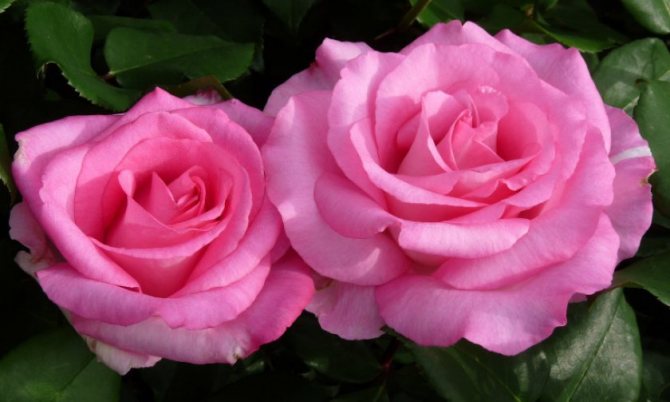

- Blue for you - the owner of delicate and touching lilac-purple flowers, which sometimes can even acquire blue hues, which harmoniously contrast with the glossy green foliage. Because of this extraordinary color of the petals, Blue for You is often mistaken for an artificial plant. Even from a distance of two meters, a dizzyingly sweet smell is caught, which combines apricot and vanilla notes. Such a unique flower cannot fail to charm. But, he is quite whimsical: he does not like either shaded or fully illuminated places, gravitates towards neutral territories. Blue and lilac buds are pleasing to the eye for only 3-4 days, after which they begin to crumble. The average height of the bush is 50 cm, but it can grow up to a meter or even more.
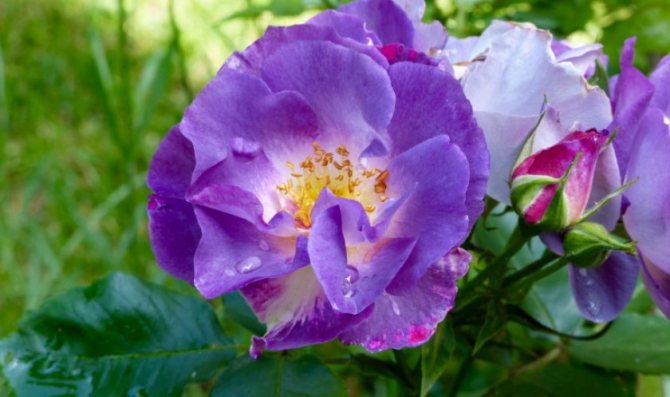

- Frau Karl Druschki... The variety borrowed its name from the wife of Karl Druschka, who headed the Society of German Friends of Roses. It has florists with impressive inflorescences with 5-6 snow-white buds, contrasting looking against the background of dark green foliage. Unopened buds have a sharp shape and pink shades, which disappear before flowering. The flowers are quite large and abundant: the average diameter is 14 cm, the shape is classic. Blooms twice a season. Representatives of the variety are formed into compact bushes, the height of which can reach more than a meter.
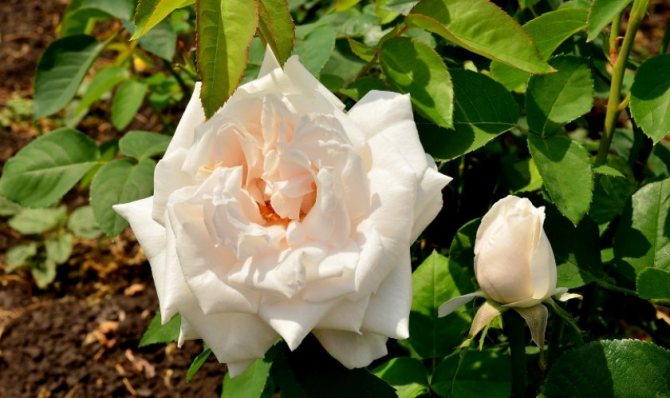

- Blue river - a variety that attracts attention with its velvet flowers of the original color: in the center there are petals of a delicate lavender color, and the edges take on magenta shades. It is important that the floral middle is never fully revealed. At the moment of full blooming, the petals give off silvery and blue hints of paint, which looks very impressive against the background of semi-glossy, dark green leaves. On average, one flower consists of 40 silky petals, and its diameter ranges from 9-11 cm. The buds grow singly, or are collected in inflorescences of 2-5 pieces. At the initial stage of flowering, they are dark crimson, but in the process of flowering they change colors. The growth of representatives of the variety can reach a meter, and the width of the bush is 75 cm. The fragrant fruity smell persists even after the petals are dried.
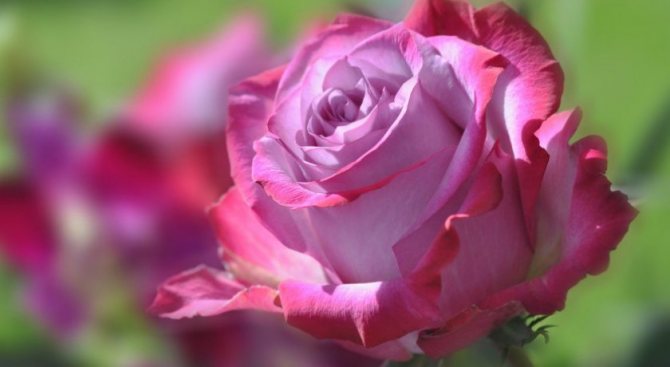

- Br>
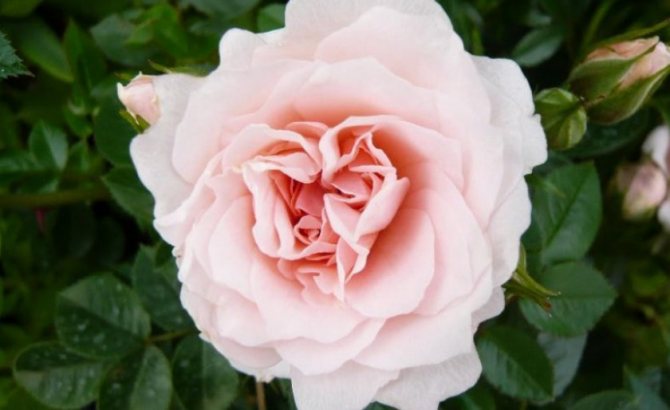

- Edit Piaf - a variety-owner of bright classic red-burgundy flowers with double petals (up to 50 of them are collected in one bud). The flower diameter is quite impressive - 10-13 cm. Thick and lush bushes grow up to 80-90 cm in length and up to 60 cm in width, covered with abundant silvery-green leaves. Double flowers emit a strong aroma with spicy-fruity notes.
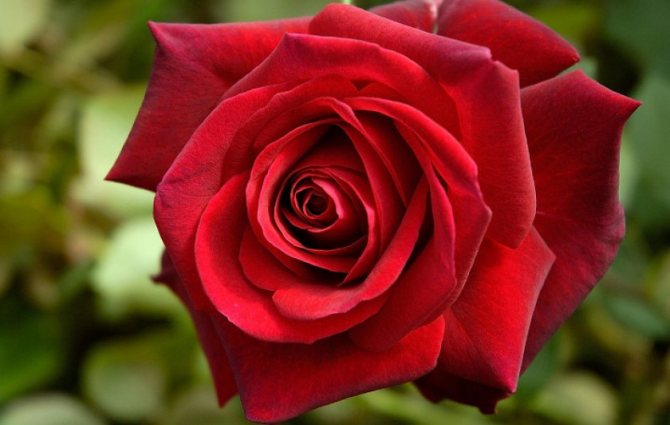

- Parole - a variety that enchants with its huge floral size (diameter - 20 cm) and an intoxicating scent, in which tea, spicy and honey-sweet accords are reunited. Not only the impressive dimensions are striking, but also the rich pink-purple fuchsia color of the petals. The bush grows 50 cm wide, 80 cm long, its stems are even and straight, which makes roses an excellent find for florists.
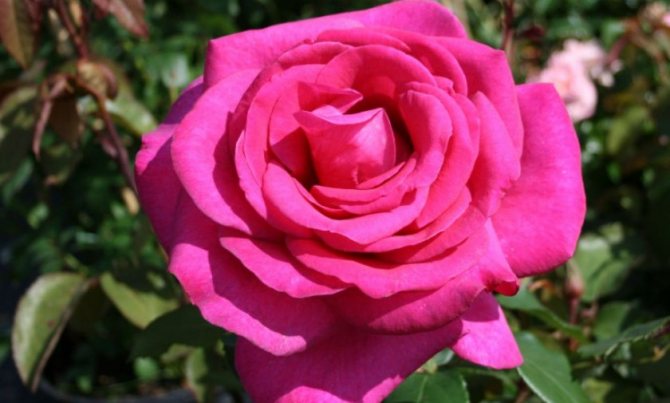

- Whiskey It stands out in the list of those listed not only by its elite name, but also by the unique fiery yellow color of wavy flower petals, the edges of which tend to orange shades. The parameters of the height and width of the bush are the same - within 80 cm. They emit a delicate sweet aroma.
